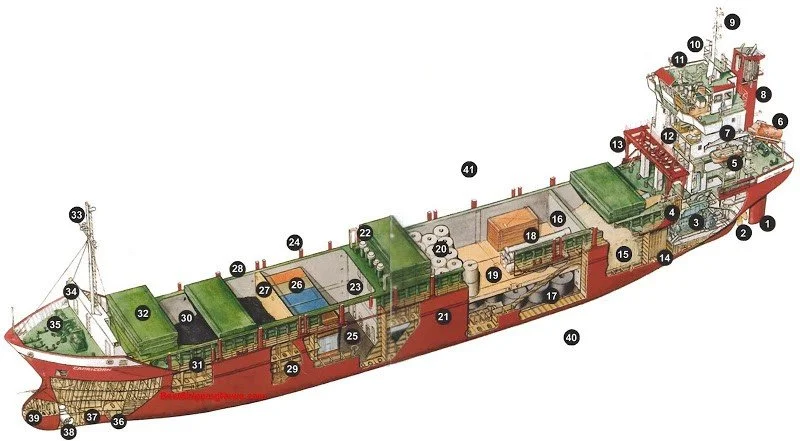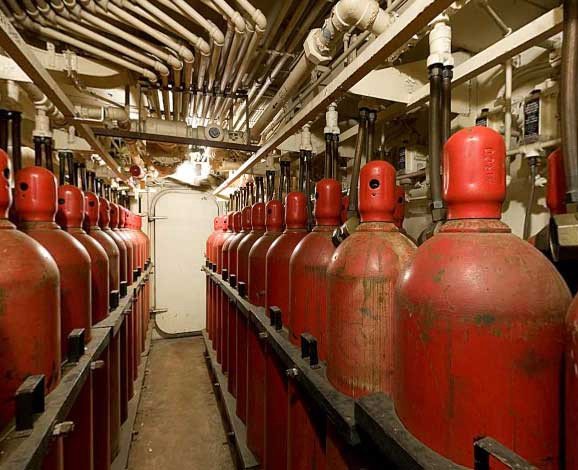A breach in the forecastle
Winter 1980
Our large Bulk carrier was making its way through North Pacific seas on a Great Circle route from Canada to Japan. Somewhere near the Aleutian Island the seas turned rough, tossing the ship around like a beach ball. Throughout the night our vessel endlessly pitches, yaws, rolls, and moans rendering the crew quiet, alert, and without sleep.
Next morning, the waves subside but the swells are still present. Upon our normal inspections of our vessel’s various spaces, the crew was shocked to find something unexpected in the CO2 room.
The CO2 room is a supersized fire extinguisher with many extinguishers connected together. The basic idea being that when a fire is detected in a critical space like the engine room, a large amount of CO2 is automatically released to smother out fire.The CO2 room often lies below the crew’s accommodation at the aft (rear) of the ship.
On this day, the crew found that this room was full of seawater!
#7 on is the usual location of the CO2 room
The crew’s accommodations are right above the CO2 room
The crew continued their frantic yet methodical rounds on deck making a list of all damages due to the previous night’s nautical drama. When they reached the forward storeroom in the forecastle, they found more destruction.
It was as if a giant hand had stirred up all the contents of the room — ropes, tools, handrails, scupper plugs, doormats, all forms of small hardware like nails, hammers, chisels — was strewn all over the room.
Things were not in ship shape
The reason for the chaos was quickly apparent. The storeroom had filled up with seawater that sloshed around during the night knocking around objects and blocking scuppers meant to drain excess water.
The Forecastle of a ship
By the afternoon the crew had figured out how such an enormous quantity of seawater entered the CO2 room under the bridge. It turned out that there was a cable duct passing all the way across the length of the ship ; all the way from the forward store-room to the CO2 room.
The ship’s see-saw motion through the immense force of the storm waves allowed seawater to enter the forecastle’s store room and make its way through the cable duct and end up all the way back to CO2 room and almost filling what was supposed to be a watertight enclosure.
The same ship of this story (now no more), the tracing shows how water entered the forecastle and made its way to the CO2 room through a cable duct and filling it to the brim.
You may ask, how did the water enter the forecastle in the first place? Aren’t they designed to protect against these events? Therein lies another set of bizarre anomalies. The ocean’s waves ended up smashing onto a trapdoor on top of a room, breaking the cover’s wing hinged studs ripping off the cover completely.
Modern ships are complex systems and such incidents cannot be pre-conceived through imagination or any amount of forethought at the time of design.
Only through subjecting them to the inexorable and random forces of Nature and then meticulously inspecting and recording the changes from a seemingly infinite number of permutations of trials, bugs, errors, leaks, freak accidents, and troubleshooting through disasters, simulated or natural, does a complex system work it’s way to resiliency.
I like to believe that such processes had a small part to play in the successful landings of the first humans on the Moon. Who knows, in a few generations a plain story such as this would be experienced on rocket ships haulin’ our mail while transiting the cosmic oceans.
Even lofty ambitions of interplanetary colonization need to be fueled by an army of Maintainers
“Just a few bumps and we’re haulin’ the mail”
The story continues for the Mariners on board
The storeroom contained about a dozen electrical motors and electrical panels, all part of the ship’s hydraulic anchoring, mooring and hatch cover opening system. They were all completely immersed in salt water and on the verge of being completely unusable.
For the next 72 hours, in freezing temperatures, the motors had to be opened, washed and cleaned with fresh, hot water and dried with electric lamps & hot. Switches and breakers were made to work correctly and the entire system was restored to its previous condition.
By the time the vessel reached its port of destination in the far-east, all machinery was working soundly leaving no clues of the the mayhem that transpired en-route.
Such is life of Maintainers on board a ship.





